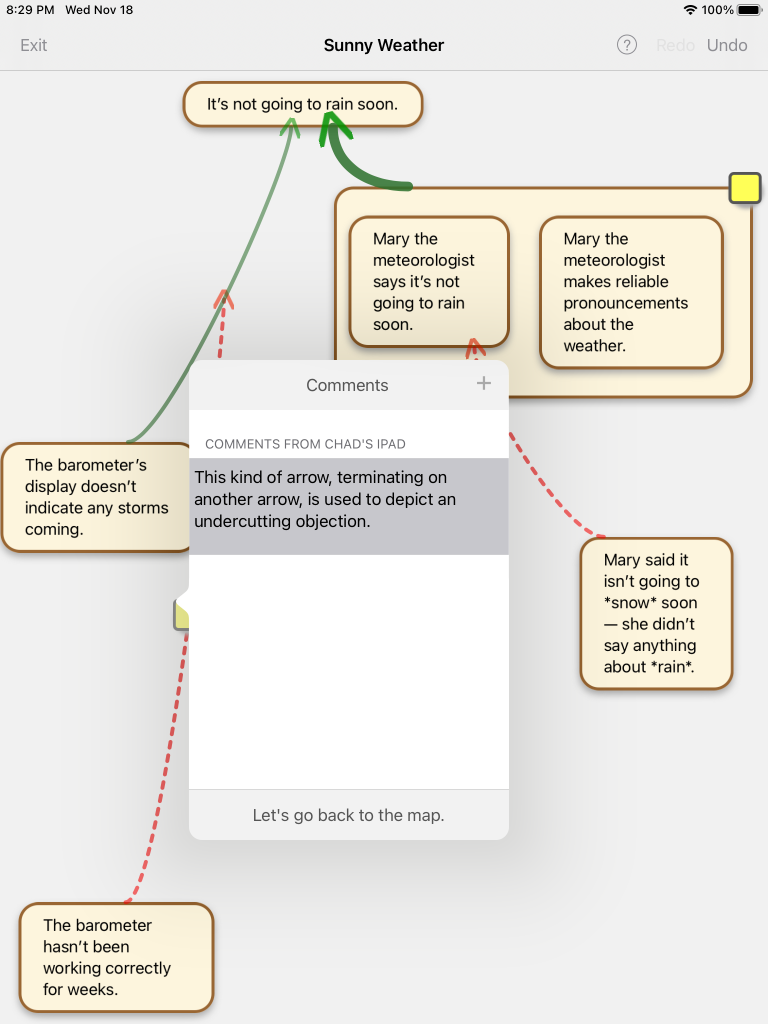![]() I am very proud to announce the launch of ArguMap and its paid-up-front sibling, ArguMap Pro. ArguMap is the world’s first iOS app specifically tailored and crafted for the creating of argument maps. You can download both ArguMap and ArguMap Pro in the App Store today!
I am very proud to announce the launch of ArguMap and its paid-up-front sibling, ArguMap Pro. ArguMap is the world’s first iOS app specifically tailored and crafted for the creating of argument maps. You can download both ArguMap and ArguMap Pro in the App Store today!
I’ve had a love of technology and All Things Apple ever since I started programming simple educational games way back in fifth grade, on one of my school’s two(!) Apple ][ computers. I am now a Professor of Philosophy at Truman State University, Missouri’s premier public liberal arts institution, where I bring my passion for technology to the classroom. I do my best to use it effectively to guide my students to a better understanding of important philosophical concepts and theories. ArguMap was borne out of my interest in helping my students develop in their ability to offer insightful philosophical arguments of their own.
Just as ordinary maps help us to figure out where to go geographically, so argument maps guide us in constructing strong arguments. By making it easy to visualize lines of reasoning, ArguMap helps its users to improve their critical thinking and reasoning skills. ArguMap is useful not just for philosophy students, but for lawyers and law school students, debate teams, scientists, English classes, professionals in public policy, and, in general, anyone who is interested in improving their ability to think critically and reason about the world.
Learning to map arguments is not a skill that comes quickly or easily to most people. The kind of intensive, reflective practice needed to become good at it can be discouraging to individuals approaching argument-mapping for the first time. If the tools that help people make argument maps get “in the way” of their thinking about the arguments, then that level of frustration only increases. Technology really can be useful in the construction of argument maps, since easily moving argument claims around on a screen helps individuals to experiment with different lines of reasoning. Unfortunately, I’ve found that software solutions for argument-mapping are frequently unwieldy and are yet one more obstacle to students as they piece together their maps.
I wanted to provide my students with a technology-facilitated mapping experience where the technology makes argument-mapping easier rather than more difficult. Not finding such a piece of software that could provide such an experience, I decided to make one myself. I have some experience as an iOS developer, so I set about creating an app. The result is ArguMap!
When designing ArguMap, I strived to ensure that the technology recedes to the background as much as possible. The touch interface of ArguMap maximally emulates physical interaction with objects. ArguMap users can move claims around on the screen just as easily as physically arranging pieces of paper. ArguMap also allows its users easily to group claims together to show how they jointly (rather than independently) provide reasons in favor of (or against) other claims. ArguMap makes that grouping of claims as easy as dragging the claims onto each other. Claims can be ungrouped just as easily, by dragging them out of a group. With simple drags and taps, ArguMap users can additionally quickly connect or disconnect parts of a map. As a result, trying out different lines of reasoning is as easy as arranging cards on a table.
With thicker or thinner connecting lines, ArguMap can also show how some claims offer stronger or weaker reasons in favor of (or against) other claims. In addition, individuals can easily provide feedback on the various parts of a map using collapsible virtual notes. Commented-on maps can then be shared with their creators via email, text message, Apple’s Classroom software, or other sharing mechanisms. This is great, for instance, for teachers to provide feedback on student work or for students to offer peer reviews of each others’ maps (which is especially useful in remote learning contexts).
Below is a screenshot showing various parts of the ArguMap interface.
And here is a link to a 30-second video clip of ArguMap in action; you can also find the embedded video below.
My Introduction to Philosophy students have really enjoyed using ArguMap to construct their argument maps, and I am eager to share the app with you. ArguMap runs on all iPads, iPhones, and iPod Touches running iOS 14 or later. It is free to download and can be used forever as an argument map viewer. Users have access to a free 30-day trial of the app’s powerful map-editing functionality. A one-time in-app purchase of $8.99 unlocks those editing features for use beyond the trial period.
Discounts of 50% are available to educational institutions who purchase 20 or more licenses of the paid-up-front version, ArguMap Pro, via the Apple School Manager program.
You can find out more information about ArguMap at its website, https://argumap.app. I am also happy to answer any questions you have about ArguMap or, in general, about my use of argument-mapping in my Introduction to Philosophy courses. You can email those questions to me. Happy mapping!
Note: parts of this post appeared in an earlier guest post I wrote for the widely read and highly regarded Daily Nous philosophy blog.
